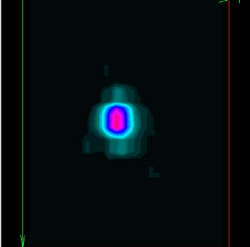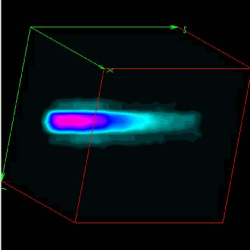Director’s Introduction
Taft Armandroff, Director, WMKO
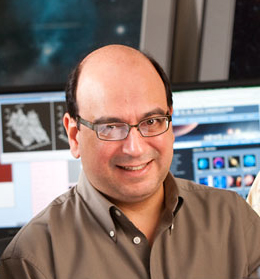 The Keck Observers’ Newsletter is one of the primary
conduits for communication with our scientific community.
As we all prepare for semester 2012A proposals, this
Newsletter and this article contain relevant and timely
information.
The Keck Observers’ Newsletter is one of the primary
conduits for communication with our scientific community.
As we all prepare for semester 2012A proposals, this
Newsletter and this article contain relevant and timely
information.
Sadly, semester 2012A will be the final semester of scientific use of the Keck Interferometer for the foreseeable future. As described in the article by Peter Wizinowich, the Keck Interferometer has provided a unique large-aperture interferometric capability for both nulling and visibility science. The NASA Astrophysics Division has been the primary supporter of Keck Interferometer development and operations. Against a backdrop of challenging budgets, NASA has announced that it will cease financial support for the Keck Interferometer after semester 2012A. As readers are undoubtedly aware, the Keck Interferometer is one of several scientific missions supported by NASA that are being terminated at this time. The operation and maintenance of the Keck Interferometer is sufficiently costly that we have been unable to identify funding to replace the NASA support. Keck Observatory leadership regrets this funding-driven closure and encourages the community to make strong use of the unique Interferometer capability in semester 2012A.
For a number of years, Keck Observatory has been implementing an advanced laser guide star adaptive optics (LGS-AO) system on the Keck I telescope. This system features a solid-state sodium laser from Lockheed Martin Coherent Technologies. As described in the article below by Jim Lyke, commissioning of this LGS-AO system is going well. We informed observers six months ago that we planned to move OSIRIS to Keck I in January 2012. The Keck I LGS-AO system has matured sufficiently that we plan to move OSIRIS to Keck I, commission it, and make it available for shared-risk science in late semester 2012A. We are hopeful that the more powerful laser projected from behind the telescope’s secondary mirror and the new fixed OSIRIS location with Keck I AO will enhance the science performance of OSIRIS.
The next great step forward in infrared observing at Keck Observatory is MOSFIRE, the Multi-Object Spectrograph for Infrared Exploration. MOSFIRE work has been underway at Caltech, UCLA, UC Santa Cruz, and WMKO for about six years now. The instrument team achieved an important milestone on April 11-12, when WMKO held a Pre-Ship Review for MOSFIRE at Caltech. A review committee of world-class instrumentation experts from Subaru, NOAO, GMT and NASA-Ames listened to presentations on the state of MOSFIRE and evaluated its readiness to be shipped to WMKO and installed on the Keck I Telescope. The review committee stated that they were very impressed with the instrument and congratulated the team. They emphasized what a capable instrument MOSFIRE is and how much it will contribute to WMKO’s instrumentation suite. The review team judged that, pending some fixes proposed by the instrument team, the instrument is ready to be shipped to Hawaii. The expertise and determination of the MOSFIRE Team, led by Co-PIs Ian McLean and Chuck Steidel, was evident during the review.
Unfortunately, one of the issues to be addressed by the team prior to shipping MOSFIRE has proven to be unexpectedly challenging: the large bearing on which the instrument rotates within the Cassegrain module has turned out to be defective, and must be repaired or (more likely) replaced. The diagnosis and isolation of the problem has required intensive engineering effort since May of this year. Since the smooth rotation of MOSFIRE is essential for maintaining accurate tracking of celestial fields on the sky, and because the bearing is an integral part of the instrument when assembled into the rotator module, the refurbishment work is best done in the high-bay lab at Caltech; thus, the instrument must remain in California until the bearing has been replaced. Although all other MOSFIRE systems are ready for commissioning, solving the bearing issue is on the critical path; at this time, it seems unlikely that commissioning can be completed during the 2011B observing semester as originally intended. Regrettably, WMKO is therefore unable to offer MOSFIRE for scientific observations in semester 2012A; however, we do expect MOSFIRE commissioning to be completed during 2012A.
On a more inspiring note, the annual Keck Science Meeting, featuring scientific results from the Keck Telescopes, will be held at the California Institute of Technology on September 23-24 (all day on Friday September 23; first half of Saturday September 24). The meeting venue is the Hameetman Auditorium in the Cahill Center for Astronomy and Astrophysics. The Organizing Committee is led by Caltech’s John Johnson. Please see the meeting web site at http://www.astro.caltech.edu/~clanton/keck_science2011. We expect another year of excellent participation from the Keck Observatory science community and great talks featuring compelling new science. ✶
Swinburne to Host Keck Science Workshop in March 2012
Duncan Forbes, Jeremy Mould, & Michael Murphy, Swinburne University of Technology
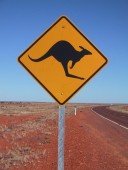 Swinburne
University of Technology announces its inaugural
workshop to highlight and discuss the latest science from
the Keck telescopes. By bringing the “Keck
‘Ohana” to Melbourne, Australia, we hope to
share our common interests and help shape future links and
collaborations. The 2-3 day workshop will begin on March
26, 2012. Invited speakers already confirmed include:
Swinburne
University of Technology announces its inaugural
workshop to highlight and discuss the latest science from
the Keck telescopes. By bringing the “Keck
‘Ohana” to Melbourne, Australia, we hope to
share our common interests and help shape future links and
collaborations. The 2-3 day workshop will begin on March
26, 2012. Invited speakers already confirmed include:
- Shri Kulkarni, Chris Martin, Chuck Steidel (Caltech)
- Jean Brodie (UCSC), Andrea Ghez (UCLA), Art Wolfe (UCSD)
- Lisa Kewley (UH)
- Taft Armandroff (WMKO)
The scientific organizing committee includes Duncan Forbes (Chair), Jeremy Mould, Shri Kulkarni, Andrea Ghez, Taft Armandroff, Jeff Cooke, and Michael Murphy. ✶
Bidding Aloha to the Keck Interferometer
Peter Wizinowich, Optical Systems Manager, WMKO
WMKO has reluctantly decided to halt science operations with the Keck Interferometer (KI) at the end of observing semester 2012A, leaving the European Very Large Telescope Interferometer as the only large aperture interferometer in the world.
The KI was built and operated with NASA funding. Interferometry had a high priority at NASA in the era when future space projects included the Terrestrial Planet Finder (TPF) and the Space Interferometer Mission (SIM), projects which the KI was intended to support. The KI completed its primary support mission in 2008 with the characterization of the zodiacal dust levels around nearby stars using nulling techniques at 10 µm.
Along the way, the KI became a powerful scientific tool not just for nulling but also for visibility measurements at H, K and L-band. Observing efficiency (~6 targets/hour) and up-time (>90%) are both extremely high. Thanks to an NSF MRI grant, the KI capabilities were further extended to higher spectral resolution (R~2000) and to fainter targets (K~12.5 demonstrated), with even higher sensitivity and an astrometric mode under development. Over its history the KI has been a ground-breaking instrument including the first fringes with a large aperture interferometer, the first interferometer with AO-correction, the first interferometric nuller, the first dual field phase referencing demonstration and the first interferometric coupling with single-mode fibers.
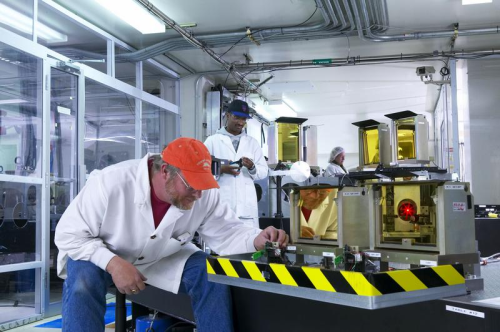
|
|
WMKO Instrument and Optics Supervisor Eric Appleby
and JPL Technician Sam Crawford inspect a
beamsplitter in the Keck Interferometer. Photo: Rick Peterson |
All of the Keck Time Allocation Committees (TACs) have allocated science time to use the KI. In the last three years the TACs typically awarded seven nights per semester. The science productivity has been good (seven refereed papers in 2010) with respect to the number of nights. The four refereed papers published so far in 2011 have included measurements of the radial structure in the TW Hya circumstellar disk, the innermost dusty structure in eight AGNs, exo-zodiacal dust levels for 25 nearby stars, and the gas and dust distribution in three FU Orionis sources.
Unfortunately, NASA has decided to cease operations funding for the KI for budgetary reasons. Also unfortunate, the Astro2010 report did not prioritize interferometry, even though it was recommended in the panel reports, making it difficult to prioritize KI operations support at the Federal level.
Given this lack of financial support, the Observatory has decided to put the KI into a storage mode at the end of semester 12A. The KI will be stored in such a manner that it could be restarted in a year or two if the funding situation were to change. Most of the required documentation is already in place. We plan to maintain the interferometer expertise required to restart KI operations by transitioning key personnel to other projects.
The KI offers unique scientific capabilities that may not be available anywhere else for some time to come. Semester 12A observing proposals will be your last chance to make use of this powerful instrument. For assistance in preparing observing proposals for KI, please see the KI support page at NExScI (http://nexsci.caltech.edu/software/KISupport/). ✶
OSIRIS to Inaugurate AO Science on Keck I
Jim Lyke, Support Astronomer, WMKO
In a long-anticipated move, the OSIRIS integral-field spectrograph will transfer from Keck II to Keck I in January 2012 and be available for shared-risk science in June 2012. The Keck I LGS team has made significant strides in readying the system for science. The most crucial milestone was installing and aligning the free-space transport (FST) system which directs the laser beam to the new Keck I center-launch telescope atop the secondary mirror; from there the beam projects into the sky, as shown below.
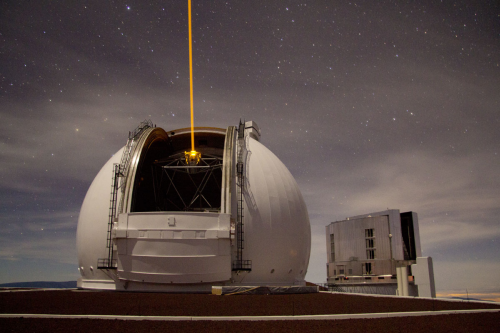
|
|
The Keck I laser projects an artificial guide
star into the sky during engineering tests in July
2011, while the Subaru Telescope observes in the
background. Photo: Andrew Cooper |
On recent engineering nights, the Keck I LGS team successfully closed all loops and tracked bright stars. Future milestones include tracking fainter targets, improving the laser output, and extending coverage to off-axis targets. Throughout the remaining engineering time, the Keck I LGS team plans to train the operations staff so that we may develop the observation procedures and automated sequences that make LGS-AO observing accessible to non-experts. Numerous challenges await, but the experience gained from commissioning and operating the Keck II LGS-AO system provides an excellent roadmap for preparing the Keck I LGS-AO system to produce great science for our Keck community of astronomers. ✶
Primary Mirror Control Systems on Keck I and II Migrate to Modern Computers
Richard Cohen, Senior Software Engineer, WMKO
Barbara Schaefer, Observing Support Coordinator, WMKO
In the Winter 2009 newsletter we reported on the plans to upgrade the Keck II primary mirror Active Control System (ACS). The upgraded ACS has been running on Keck II since May 28, 2010, with excellent performance and reliability. We are now preparing to upgrade the Keck I ACS with an identical system. Daytime testing is underway, on-sky testing is planned for the August segment exchange, and we hope to start using the Keck I ACS upgrade for science by the end of August.
The main advantage of the new system is that it does not rely on obsolete hardware. In the upgraded system, general purpose, off-the-shelf devices — a Sun server and a set of five terminal servers for serial communications with the node boxes — replace the obsolete, 10-processor VME computer system used previously. Other improvements include an enhanced GUI, better fault detection/recovery and more extensive telemetry logging to aid in troubleshooting and performance monitoring. Most computer platform and operating system dependencies were removed from the software to facilitate future upgrades. When the Keck I upgrade is complete, both of our telescopes will have a reliable and maintainable ACS for many years to come. ✶
Telescope Mirror Recoatings Keep the Photons Flowing In
Barbara Schaefer, Observing Support Coordinator, WMKO
Take a mirror, add a pristine aluminum coating, put it at the summit of Mauna Kea where the airborne cinder and sulfuric acid do their worst, and soon you no longer have a nice, shiny mirror. Generally, the decay in reflectance takes a year or so to become noticeable, but eventually it becomes worthwhile to recoat the optics and restore the shine. To maintain the throughput of these great telescopes, we carry out a regular program of recoating not only the 36 primary mirror segments on each telescope, but also the secondary and tertiary mirrors.
We last reported on the state of the Keck Telescopes’ optics in the Summer 2010 newsletter. Our most recent segment exchange on Keck II was in September of 2010. After that exchange, two segments within the Keck II primary array remained to be realuminized. Of these two remaining segments, one was deemed too risky to remove from the telescope because of concerns over cracks in the glass at the axial pads, and another was difficult to access given its location next to the tertiary tower. Rather than devote a whole segment exchange day (and subsequent on-sky engineering time) simply to recoat the one remaining segment, we decided instead to begin recoating segments on Keck I starting with the October 2010 exchange.
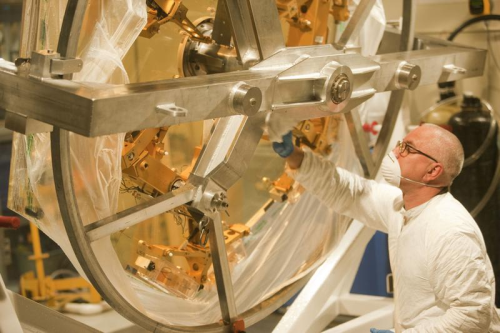
|
|
WMKO technician Steve Doyle inspects a
primary mirror segment which has been stripped and
cleaned in preparation for re-aluminizing. Photo: Rick Peterson |
Transitioning our segment exchange effort from Keck II to Keck I brought a new set of challenges. For the initial exchange in October 2010, refining the procedure on a different telescope required us to reduce the number of segments we exchanged each day from three to two in order to protect the optics. We took a hiatus last winter, then resumed the Keck I exchanges in April, May, and June of this year.
Over the winter, we refurbished our summit mirror coating chamber and conducted an external review of our tertiary mirror handling procedures to assure continued safety of this crucial optic. The suggestions and lessons learned during the review were put to good use when the Keck II tertiary was recoated in December 2010. Recoating of the Keck I tertiary, last re-aluminized in 2008, is planned for the fall of 2011.
A secondary mirror handling review was held in July 2011, resulting in a successfully-recoated Keck I secondary mirror and revised handling procedures for these optics. Recoating of the Keck II secondary, which last received a new coating in December 2007, is now planned for summer of 2012. As you can appreciate, maintaining high reflectivity on the secondary mirrors is critically important to the throughput of the telescope, since all of the light must bounce off this mirror; the tertiary mirror is equally crucial when observing at the Nasmyth focus. Exchanging one segment has only 1/36 of the effect we get from recoating the secondary or tertiary.
Keck I segment exchanges will begin again in August and continue through October, after which all but four segments will have been exchanged. These four segments, all of which exhibit cracks at either the axial or radial pads, will remain in the Keck I mirror until the development of the segment repair process is complete.
An external review of the segment axial pad crack repair process is scheduled to be held in October 2011, with segment repairs to begin shortly after that. The radial pad crack repair process will be addressed next.
In our ongoing quest to keep fresh, shiny, highly-reflective and efficient optics available for our scientists, we plan to begin the primary mirror segment recoating cycle again on Keck II in spring of 2012. ✶
Massive Monitors Lend “Mission Control” Aura to Waimea Remote Ops
Jim Lyke, Support Astronomer, WMKO
Over the years, one of the more common requests we've received from our observers has been to equip our Remote Ops room in Waimea with dedicated screens for viewing the FACSUM and XMET windows that provide updates on the telescope and weather, respectively. At long last, we're happy to report that we've finally done that — and more!
If you’ve observed from Waimea recently, you’ve likely noticed the new additions to the Remote Ops rooms: giant wall monitors with all the telescope and weather information you could ever want! The new monitors — one each for each remote ops room — are split in half. One side displays FACSUM and XMET constantly and the other hosts a browser that cycles through weather and sky conditions.
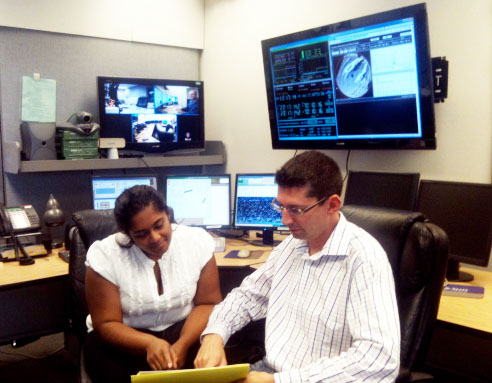
|
| Support Astronomer Luca Rizzi assists visiting researcher Christina Balkaran while the giant new wall-mounted monitor towers over them. |
The current lineup of pages periodically displayed on the wall monitor includes:
- Mauna Kea All-Sky Camera;
- CFHT ASIVA, a new all-sky IR camera for monitoring clouds;
- CFHT Skyprobe, a quantitative indicator of transparency;
- CFHT Cloudcams, a new tool for detecting fog rolling up the ridge from the East;
- Mauna Kea Seeing measured with the MASS/DIMM;
- Mauna Kea Current Conditions, a weather overview;
- Satellite Loop showing the Pacific weather movie from space.
Science Highlight: 3-D Spectroscopy of z~3 Lyman-alpha-Emitting Galaxies with the ESI Integral Field Unit
Wallace L. W. Sargent, Caltech
Michael Rauch, Observatories of the Carnegie Institution of Washington
Recent years have seen a surge in interest in the formation of early galaxies from gas, and in the exchange of matter and radiation between a galaxy and the perigalactic gaseous environment. Traditionally, studies of gas at cosmological distances have relied on the extremely sensitive but essentially one-dimensional information from QSO absorption lines.
In a complementary approach, probing galactic halo gas in emission lines, while less sensitive, can provide two-dimensional spatial sampling and gives more weight to parts of a galaxy more closely associated with the sources of ionizing photons.
The best tracer of tenuous gas in emission in the early universe is the Lyman alpha line of neutral hydrogen. Hot stars in a galaxy emit ionizing radiation that is converted by the ambient neutral hydrogen gas into Lyman alpha, but there may also be other sources of Lyman alpha, e.g., cooling radiation. Arising in a resonance transition under highly optically thick conditions, Lyman alpha photons undergo many absorption and re-emission events, until they finally escape the gaseous halo of a galaxy. Along the way, the photons pick up information on the density and velocity field of the gas. This information, encoded in the surface brightness profile as a function of wavelength, can be modeled to tell us about the physical conditions of the gas, e.g., whether it is falling in or flowing out, and about the nature and distribution of the ionizing sources inside the galaxy.
Last fall we began a study of the spatial and kinematic distribution of Lyman alpha emission in a few individual galactic halos at high redshift, using the ESI Integral Field Unit (ESI-IFU; Sheinis et al. 2003). Ordinary Lyman-alpha-emitting galaxies have generally not been observed before with IFUs and at the excellent spectral resolution afforded by ESI. With realistic exposure times on the order of a night per object, Lyman alpha emission can be traced out to radii of several arcseconds from the centers of the brightest redshift-three Lyman alpha emitters, a scale well matched by the aperture (4"×5.65") of this instrument. The ESI IFU slices the spectral aperture into 5 slits, the light of which is then reflected in a linear arrangement onto the ESI slit and dispersed in the usual way, with a resolution of about 90 km s-1. The spatial sampling is determined by the slit width (1.13") of the five stacked slits in one direction, and the pixel size (0.15") along the slits in the other. The resulting spectra can be reassembled into data cubes that allow slices or projections to be taken along any of the three directions. The spatial coherence of the apertures along the five individual 4" long slits of the image slicer design of the ESI-IFU is an attractive feature for sky-background-dominated, low-light-level observations, as it avoids the sensitivity variations found sometimes with fiber-fed IFUs and allows for close inspection of variations in surface brightness along the slit.
Because of the large spatial extent of Lyman alpha halos, a precise centering in the IFU is desirable to avoid having part of the object fall outside of the aperture. WMKO provides a set of highly useful routines that considerably reduce the overhead of setting up on the target. The actual pointing origin for the IFU center is determined from an analysis of a short raw spectral exposure of a brighter source and suggests corrections to the telescope position, eliminating error-prone guesswork about the directions and sizes of any corrective moves. This approach can be applied even to objects like the Lyman alpha targets which often consist of a single emission line with no detectable continuum. Another routine enables the telescope operator to relatively painlessly switch between the different instrument foci, as the IFU is not confocal with the ESI slit-plate.
Figure 1 shows the first results of our survey, the spectral data cube of a bright emitter at redshift 3.1, obtained in 18,000 s of exposure time in 2010 November. To maximize the signal-to-noise ratio we started out observing some of the brightest Lyman alpha emitters known (short of the ultra-luminous Lyman alpha blob regime), objects discovered in the Subaru surveys by collaborators Ouchi, Ono and their colleagues. ✶
Keck’s Adaptive Optics Systems Produce Great Astronomical Science
Peter Wizinowich, Optical Systems Manager, WMKO
The Keck II Natural Guide Star (NGS) Adaptive Optics (AO) system saw first light in February 1999 and the first science paper with this system was published in January 2000. First light with the Laser Guide Star (LGS) capability occurred in September 2003 with publication of the first science paper in May 2005. As of June 2011, a total of 213 refereed science papers have been published based on Keck NGS AO data and 113 with the Keck LGS AO system. This article provides an overview of the first decade of scientific productivity with Keck AO.
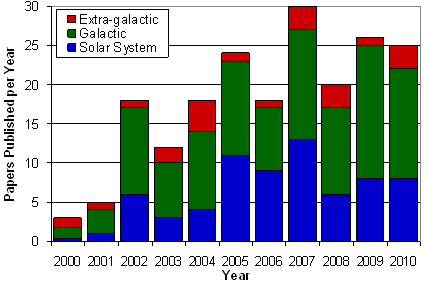
|
| Figure 2. Refereed Keck II NGS AO science papers published each year. |
Figure 2 and Figure 3 plot the number of refereed science papers published each year based on Keck NGS and LGS AO data, respectively. These plots group the science papers into three broad categories: solar system, galactic, and extra-galactic science.

|
| Figure 3. Refereed Keck II LGS AO science papers published each year. |
The type of science has changed with the advent of LGS AO as shown in Table 1. NGS AO is sufficient for the study of many solar system and galactic objects whereas LGS AO has opened up the extra-galactic field and allowed observations of new Galactic objects.
| Category | NGS Papers | LGS Papers |
|---|---|---|
| Galactic | 56% | 47% |
| Extra-galactic | 11% | 45% |
| Solar System | 33% | 7% |
A more detailed breakdown of the types of science being performed with the LGS AO system is provided in Table 2.
| Category | Subcategory | Papers |
|---|---|---|
| Galactic | Brown dwarfs & low mass stars | 32 |
| Galactic Center | 15 | |
| Compact objects | 3 | |
| Nova | 1 | |
| Disks | 2 | |
| Extra-galactic | High redshift galaxies | 21 |
| Supernovae | 8 | |
| Gravitational lensing | 9 | |
| Stellar populations | 7 | |
| AGN | 4 | |
| Gamma Ray Burst | 1 | |
| Interstellar Medium | 1 | |
| Solar System | Kuiper Belt | 4 |
| Planets | 2 | |
| Asteroids | 2 |
The refereed AO science papers by instrument and year are shown in Figure 4. NIRC2 has been the most productive Keck AO instrument with 209 of the papers, representing 64% of the total. KCAM was the engineering camera used for first science and SCAM is the slit viewing imager in the NIRSPEC instrument; IF is the interferometer which uses both the Keck I and II AO systems.
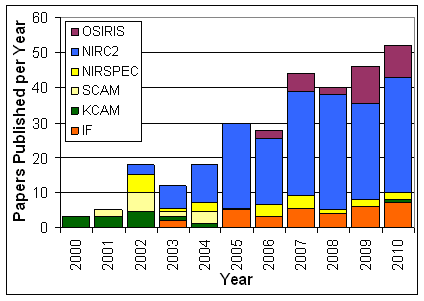
|
| Figure 4. Keck II AO refereed science papers published each year by science instrument |
Figure 5 is a plot of the percentage of Keck II science nights assigned to AO science observations by the time allocation committees (TACs). The NIRC2, OSIRIS and NIRSPEC science instruments are used with both NGS and LGS AO modes while the two interferometer capabilities, V2 and nuller, have only been used in NGS mode. The spike in nuller allocation in 2008 was due to a NASA key science program to measure dust around nearby stars.

|
| Figure 5. Percentage of Keck II nights allocated to AO science by instrument and year. |
It is difficult to compare science productivity between instruments. One potentially illustrative comparison, with plenty of caveats, is provided in Figure 6 which compares the TAC-allocated science time and refereed science papers by instrument for a single year. The optical instruments had 60% of the science time in 2009 and produced 72% of the 2010 papers in this comparison. The seeing-limited near-IR instruments had 16% of the science time and produced 9% of the science papers. The AO science instruments had 25% of the science time and produced 18% of the papers. NIRC2 was the most productive AO instrument with 11% of the science nights and 12% of the papers. OSIRIS is a newer instrument and its paper count has been relatively low so far for a number of reasons (potential sensitivity improvements are under development).
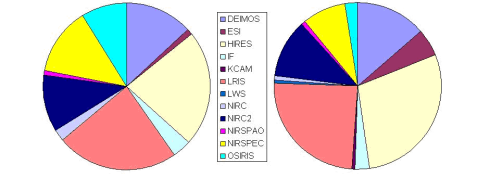
|
| Figure 6. TAC-allocated science nights in 2009 (left) and refereed science papers in 2010 (right) by Keck science instrument (click to enlarge). |
Table 3 lists the Keck AO-based papers published in 2010 by journal and type of science. The majority of the Keck AO-based papers (58%) are published in the Astrophysical Journal (including ApJL).
| Journal | Solar System | Galactic | Extragalactic | 2010 Total | ||||||
|---|---|---|---|---|---|---|---|---|---|---|
| LGS | NGS | IF | LGS | NGS | IF | LGS | NGS | |||
| A&A | 2 | 1 | 1 | 1 | 1 | 6 | ||||
| AJ | 2 | 1 | 4 | 7 | ||||||
| ApJ | 5 | 6.5 | 5.5 | 1 | 6 | 24 | ||||
| ApJL | 1 | 1 | 3 | 1 | 6 | |||||
| ICARUS | 2 | 5 | 7 | |||||||
| MNRAS | 1 | 1 | ||||||||
| Nature | 1 | 1 | ||||||||
| 2010 Total | 2 | 8 | 6 | 8.5 | 9.5 | 1 | 15 | 2 | 52 | |
A measure of AO’s impact is its usage by students. A total of 41 PhD dissertations published in 2009 and 2010 referenced data collected at Keck Observatory; 44% of these dissertations made use of Keck AO data.
Keck AO’s productivity with respect to other AO facilities is illustrated in Figure 7 and Table 4. Figure 7 shows all of the LGS AO refereed science papers published world-wide through 2010 by year and Observatory. The Keck LGS system has produced 75% of all LGS papers from 2004 to 2010.
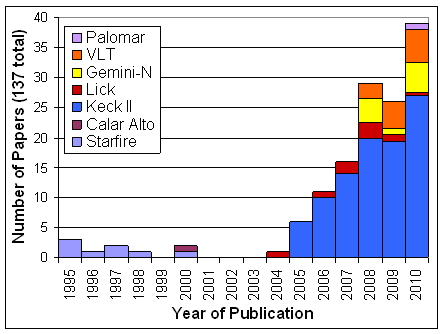
|
| Figure 7. Number of refereed astronomical science papers published each year using data from all LGS AO systems world-wide. |
The refereed AO-based science papers published in the Astrophysical Journal in 2010 are listed by AO system and type of science in Table 4. Although ApJ is only one of several journals used to publish astronomical science (European astronomers may favor A&A, for example), the high fraction of AO papers in this prestigious journal which involves Keck (46%) testifies to the high impact of our AO system.
| System | Solar System | Galactic | Extragalactic | ApJ 2010 Total | |||||
|---|---|---|---|---|---|---|---|---|---|
| LGS | NGS | IF | LGS | NGS | IF | LGS | NGS | ||
| Keck II AO | 1 | 5 | 6.5 | 6.5 | 1 | 9 | 1 | 30.0 | |
| Gemini ALTAIR | 1.5 | 2.5 | 1 | 2 | 7.0 | ||||
| Gemini NICI | 1.3 | 1 | 2.3 | ||||||
| Subaru AO188 | 1 | 1 | 2.0 | ||||||
| VLT NACO | 0.3 | 3.6 | 2 | 5.8 | |||||
| VLT MAD | 2 | 2.0 | |||||||
| VLT SINFONI | 0.8 | 0.8 | 1 | 2.5 | |||||
| VLT CRIRES | 1 | 1.0 | |||||||
| VLT MACAO | 1 | 1.0 | |||||||
| AEOS LYOT | 1.5 | 1.5 | |||||||
| CFHT PUEO | 1 | 1.0 | |||||||
| MMT AO | 3.3 | 3.3 | |||||||
| Palomar PALAO | 1 | 4.5 | 5.5 | ||||||
| ApJ 2010 Total | 1 | 6 | 10 | 29 | 1 | 10 | 8 | 65 | |
The Observatory, as part of its strategic vision, will continue its efforts to provide improved AO capabilities to support the cutting edge high angular resolution science being done by the Keck user community. Improvements that should start bearing scientific fruit over the next two years include a higher performance LGS AO system on Keck I, improved Keck II LGS AO performance with projection of the laser from behind the telescope’s secondary mirror, and a near-infrared tip-tilt sensor with the Keck I AO system. In the longer term, we continue to seek funding for a Next Generation AO (NGAO) facility which has successfully completed its preliminary design review but is currently unfunded.
Science with AO has come a long way over the past decade and AO at Keck has played a significant role in this high angular resolution revolution. Keck AO has enabled a wide range of astronomical science over this time and it has been adopted, and is in demand, by a large segment of our user community. Scientific productivity is good in the context of the other Keck science instruments, and Keck AO is doing well, and Keck LGS AO is doing very well, with respect to AO systems on the other large telescopes. ✶
Pair of Talented Astronomers Join Keck's Observing Support Team
Bob Goodrich, Observing Support Manager, WMKO
Last issue we announced some departures from and additions to Observing Support and elsewhere at the Observatory. This issue we would like to announce a couple of additions to the Support Astronomer group.
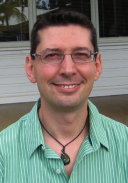 In May, Luca Rizzi joined our group from UKIRT, where he
provided support for WFCAM and the massive UKIDSS
survey. Born in Schio, Italy, Luca earned his
Ph. D. from University of Padua, subsequently taking
on a postdoctoral role at Univ. of Hawaii. He is an
expert on stellar populations in local galaxies, and has
extensive support and observing experience. At Keck Luca
is taking on support of LRIS and DEIMOS initially.
In May, Luca Rizzi joined our group from UKIRT, where he
provided support for WFCAM and the massive UKIDSS
survey. Born in Schio, Italy, Luca earned his
Ph. D. from University of Padua, subsequently taking
on a postdoctoral role at Univ. of Hawaii. He is an
expert on stellar populations in local galaxies, and has
extensive support and observing experience. At Keck Luca
is taking on support of LRIS and DEIMOS initially.
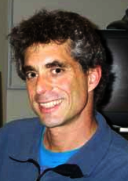 This month (August 2011) Greg Doppmann comes to us from
NOAO, where he provides support for the 0.9 m WIYN
and 4 m Mayall telescopes, as well as support for
Gemini proposals and phase 2 preparation. Previously Greg
served as the Instrument Scientist for GNIRS at
Gemini-S. Greg has had significant instrument building
experience, both during his tenure at Univ. of Texas
Austin (where he earned his Ph. D.) and
elsewhere. Greg is an expert on protostars and stellar
formation, and will cut his teeth on NIRSPEC and HIRES
support at Keck in the near future.
This month (August 2011) Greg Doppmann comes to us from
NOAO, where he provides support for the 0.9 m WIYN
and 4 m Mayall telescopes, as well as support for
Gemini proposals and phase 2 preparation. Previously Greg
served as the Instrument Scientist for GNIRS at
Gemini-S. Greg has had significant instrument building
experience, both during his tenure at Univ. of Texas
Austin (where he earned his Ph. D.) and
elsewhere. Greg is an expert on protostars and stellar
formation, and will cut his teeth on NIRSPEC and HIRES
support at Keck in the near future.
We are very excited to have Luca and Greg on board. Please stop by their offices and say hello when you’re here observing. ✶
Back Issues
Please see the Keck Observers’ Newsletter Archive.

